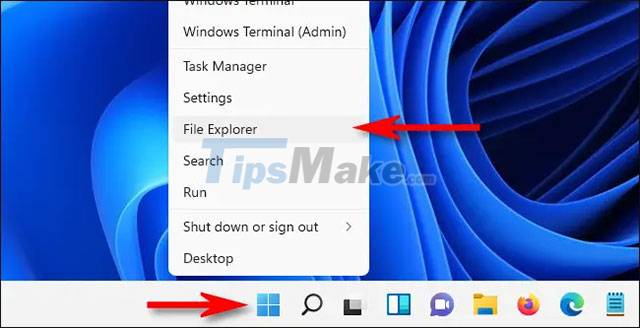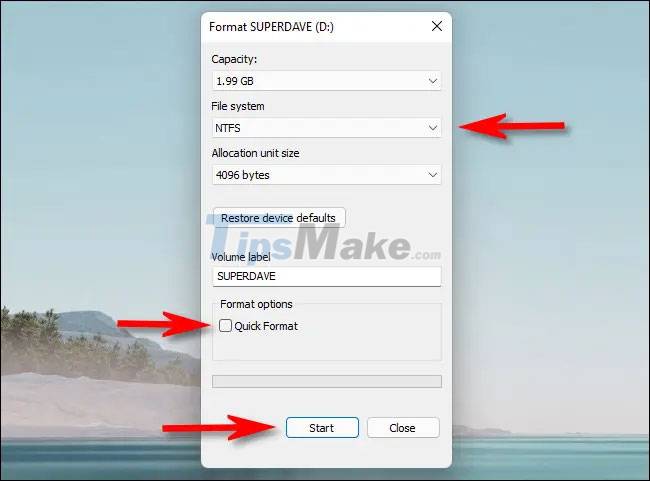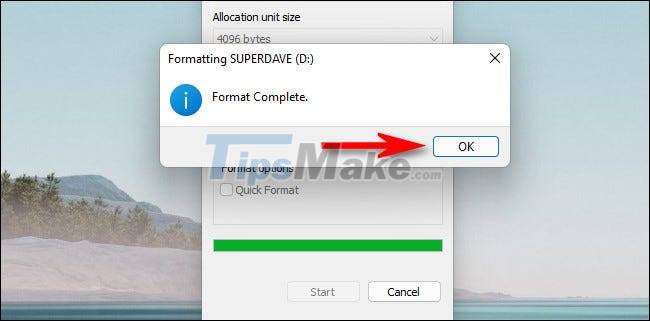How to format the hard drive on Windows 11
Then, instead of choosing to manually delete folders, which is very time consuming and incomplete, you should immediately think about formatting the hard drive. This will not only completely erase the data on the hard drive, but also keep it in the most optimal ready-to-use state,
Find out how to do it right here.
Format the hard drive on Windows 11
First, open File Explorer. by clicking the folder icon on the taskbar at the bottom of the screen. Or you can right click on the Start button and select 'File Explorer'.

On the File Explorer window that opens, click on the item to 'This PC'. Immediately, a list of 'Devices and Drives' will appear, which lists all available hard drives and storage devices on the system. Right-click the hard drive you want to format and select 'Format' in the menu that appears.

The 'Format' window will open, which contains options for how you want to format the hard drive. We will look at each item in detail below.
- Capacity: This will be the data capacity of the hard drive after it is formatted. Formatting takes up a small amount of raw hard drive space due to the way the file system works.
- File System: A file system is a data structure that tells the operating system how to save/load files to or from the hard drive. Depending on the size of the hard drive, your options will be FAT, FAT32, NTFS, or exFAT. In general, you will want to choose NTFS if the hard drive is only used with Windows. If you want the hard drive to be readable and writable on your Mac as well, choose exFAT.
- Allocation Unit Size: This is the basic block size used by the file system when you format the hard drive. In general, you rarely need to modify this setting, so use the default allocation unit size (usually 4096 bytes for NTFS) when selecting File System.
- Volume Label: This is the name of the hard drive in File Explorer.
- Format Options (Quick Format): If the hard drive is working fine, you can select 'Quick Format', which performs a quick and advanced format process. The data remains on the hard drive but all references to it are lost, so it will be overwritten. In other words, Quick Format means removing and creating a new FAT so that the storage drive can be reused. However, the old data persists until it is recorded. If the drive hasn't been written, someone else can find out what's stored on it, using one of the data recovery tools. If you don't select Quick Format, Windows will check each sector of the drive with a low-level format that takes longer, but will also completely erase all traces of old data.
Once you've selected the options you want, click 'Start' to begin the formatting process.

Immediately, Windows will display a warning with the content 'Formatting will erase ALL data on this disk'. Click 'OK' if you are ready to clean the hard drive.

While the format is in progress, you will see a small window appear showing the current process. When it's done, you'll see another notification window pop up. Click 'OK'.

Repeat the above process with the other hard drives you want to format. Hope you are succesful.
You should read it
- How to reformat an external hard drive does not cause data loss
- How to identify hard drive failure, hard drive failure, bad hard drive on Windows
- How to Format a Hard Drive
- Dissection of hard drive components
- What is a hard drive? There are several types?
- How to Format a Hard Disk
- How to Format a hard drive with the CMD command
- Top 10 free and easy-to-use hard drive dividers and formats
May be interested
- How to install, set up and access LAN on Windows 11
 instructions on how to install lan, set up lan and access lan on windows 11 in detail with pictures
instructions on how to install lan, set up lan and access lan on windows 11 in detail with pictures - How to set up automatic emptying of the recycle bin in Windows 11
 recycle bin is an area familiar to windows users in general. this is where the files and folders you delete (accidentally or on purpose) are stored, and allows you to undo files and folders to use again when needed.
recycle bin is an area familiar to windows users in general. this is where the files and folders you delete (accidentally or on purpose) are stored, and allows you to undo files and folders to use again when needed. - How to change the color of Windows 11 computer screen suitable for the blind
 windows 11 supports you with the computer screen color filter feature color filters. here, i will guide you how to change the color of your windows 11 computer screen...
windows 11 supports you with the computer screen color filter feature color filters. here, i will guide you how to change the color of your windows 11 computer screen... - How to install (and uninstall) fonts on Windows 11
 in many cases, the nature of your work makes you want to install more fonts. or vice versa, sometimes you may also want to get rid of problematic or rarely used fonts.
in many cases, the nature of your work makes you want to install more fonts. or vice versa, sometimes you may also want to get rid of problematic or rarely used fonts. - How to fix the position of icons on the Windows 11 desktop
 the layout of icons on your windows 11 desktop can sometimes get messy when you restart the system, or download a new application and add its shortcut to the home screen.
the layout of icons on your windows 11 desktop can sometimes get messy when you restart the system, or download a new application and add its shortcut to the home screen. - How to open multiple images side by side for comparison on Windows 11
 sometimes you want to put two or more photos side by side for comparison, to find the difference in quality, content, or anything between them.
sometimes you want to put two or more photos side by side for comparison, to find the difference in quality, content, or anything between them.





 How to format the hard drive on Windows
How to format the hard drive on Windows How to format a hard drive into NTFS in Linux
How to format a hard drive into NTFS in Linux How to Format a hard drive with the CMD command
How to Format a hard drive with the CMD command How to format hard drive on Windows, Mac computer simply and effectively
How to format hard drive on Windows, Mac computer simply and effectively How to fix unformatted hard drive?
How to fix unformatted hard drive?